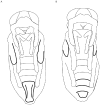The parasitoid wasp Nasonia: an emerging model system with haploid male genetics
- PMID: 20147035
- PMCID: PMC2916733
- DOI: 10.1101/pdb.emo134
The parasitoid wasp Nasonia: an emerging model system with haploid male genetics
Abstract
Nasonia is a complex of four closely related species of wasps that is rapidly emerging as a model for evolutionary and developmental genetics. It has several features that make it an excellent genetic system, including a short generation time, ease of rearing, interfertile species, visible and molecular markers, and a sequenced genome. The form of sex determination, called "haplodiploidy," makes Nasonia particularly suitable as a genetic tool. Females are diploid and develop from fertilized eggs, whereas males are haploid and develop from unfertilized eggs. This allows geneticists to exploit many of the advantages of haploid genetics in an otherwise complex eukaryotic organism. Nasonia readily inbreeds, permitting production of isogenic lines, and the four species in the genus are interfertile (after removal of the endosymbiont Wolbachia), facilitating movement of genes between the species for efficient positional cloning of quantitative trait loci (QTL). Genome sequencing of the genetic model Nasonia vitripennis and two interfertile species, Nasonia giraulti and Nasonia longicornis, is now completed. This genome project provides a wealth of interspecies polymorphisms (e.g., single nucleotide polymorphisms [SNPs], insertion-deletions [indels], microsatellites) to facilitate positional cloning of genes involved in species differences in behavior, morphology, and development. Advances in the genetics of this system also open a path for improvement of parasitoid insects as agents of pest control.
Figures






Similar articles
-
Haploid females in the parasitic wasp Nasonia vitripennis.Science. 2007 Jan 12;315(5809):206. doi: 10.1126/science.1133388. Science. 2007. PMID: 17218519
-
No patrigenes required for femaleness in the haplodiploid wasp Nasonia vitripennis.Genetics. 2006 Feb;172(2):981-9. doi: 10.1534/genetics.105.044743. Epub 2005 Oct 11. Genetics. 2006. PMID: 16219780 Free PMC article.
-
Fine-scale mapping of the Nasonia genome to chromosomes using a high-density genotyping microarray.G3 (Bethesda). 2013 Feb;3(2):205-15. doi: 10.1534/g3.112.004739. Epub 2013 Feb 1. G3 (Bethesda). 2013. PMID: 23390597 Free PMC article.
-
The jewel wasp Nasonia: querying the genome with haplo-diploid genetics.Genesis. 2003 Mar;35(3):185-91. doi: 10.1002/gene.10189. Genesis. 2003. PMID: 12640624 Review.
-
The expanding genetic toolbox of the wasp Nasonia vitripennis and its relatives.Genetics. 2015 Apr;199(4):897-904. doi: 10.1534/genetics.112.147512. Genetics. 2015. PMID: 25855650 Free PMC article. Review.
Cited by
-
Reproductive isolation due to prezygotic isolation and postzygotic cytoplasmic incompatibility in parasitoid wasps.Ecol Evol. 2019 Aug 20;9(18):10694-10706. doi: 10.1002/ece3.5588. eCollection 2019 Sep. Ecol Evol. 2019. PMID: 31632650 Free PMC article.
-
The torso-like gene functions to maintain the structure of the vitelline membrane in Nasonia vitripennis, implying its co-option into Drosophila axis formation.Biol Open. 2019 Sep 25;8(9):bio046284. doi: 10.1242/bio.046284. Biol Open. 2019. PMID: 31488408 Free PMC article.
-
Non-coding changes cause sex-specific wing size differences between closely related species of Nasonia.PLoS Genet. 2010 Jan 15;6(1):e1000821. doi: 10.1371/journal.pgen.1000821. PLoS Genet. 2010. PMID: 20090834 Free PMC article.
-
Genetic Incompatibilities Between Mitochondria and Nuclear Genes: Effect on Gene Flow and Speciation.Front Genet. 2019 Feb 13;10:62. doi: 10.3389/fgene.2019.00062. eCollection 2019. Front Genet. 2019. PMID: 30853974 Free PMC article.
-
The emergence of ecotypes in a parasitoid wasp: a case of incipient sympatric speciation in Hymenoptera?BMC Ecol Evol. 2021 Nov 15;21(1):204. doi: 10.1186/s12862-021-01938-y. BMC Ecol Evol. 2021. PMID: 34781897 Free PMC article.
References
-
- Saunders DD. Larval Diapause of Maternal Origin: Induction of Diapause in Nasonia vitripennis (Walk.) (Hymenoptera: Pteromalidae) Journal of Experimental Biology. 1965;42:495.
-
- Lynch JA, Desplan C. A method for parental RNA interference in the wasp Nasonia vitripennis. Nature Protocols. 1:486–494. - PubMed
Protocol 6 References
-
- Breeuwer JAJ, Werren JH. Microorganisms Associated With Chromosome Destruction and Reproductive Isolation Between Two Insect Species. Nature. 1990;346:558–560. - PubMed
REFERENCES AND RESOURCES
-
- Beukeboom L, Werren JH. The paternal-sex-ratio (PSR) chromosome in natural populations of Nasonia (Hymenoptera: Chalcidoidea) J Evol Biol. 2000;13:967–975.
-
- Beukeboom L, Desplan C. Nasonia. Current Biology. 2003;13:R860. - PubMed
-
- Beye M, Hasselmann M, Fondrk MK, Page RE, Omholt SW. The gene csd is the primary signal for sexual development in the honeybee and encodes an SR-type protein. Cell. 2003;114:419–429. - PubMed
-
- Bordenstein SR, O’Hara FP, Werren JH. Wolbachia-induced incompatibility precedes other hybrid incompatibilities in Nasonia. Nature. 2001;409:707–710. - PubMed
Publication types
MeSH terms
Grants and funding
LinkOut - more resources
Full Text Sources
